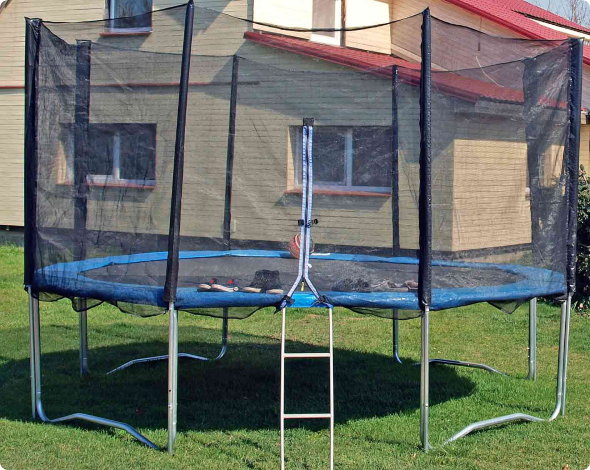Is Trampoline Insurance Included in My Homeowners Insurance?
Updated April 8, 2024 . AmFam Team
Jumping! Twisting! Flipping! There’s no denying trampolines are a fun outdoor activity for kids to burn off some energy in the summertime. But if you’re thinking about getting a trampoline for your home, you’ll first want to check how — and if — your homeowners insurance protects you.
So, does homeowners insurance cover trampolines? Actually, most insurance companies do not cover trampolines because they consider them too costly due to liability risks. On the other hand, some companies may insure your trampoline if you have the right safety equipment and other safety precautions in place. In short, trampolines likely won’t be covered by your standard homeowners policy, and you’ll have to work with your insurance company to make sure the right protection is added.
Let’s take a closer look at homeowners insurance for trampolines.
Do you need trampoline insurance?
If you have a trampoline you’ll most definitely want to have insurance coverage. Trampolines are a lot of fun, but they can be dangerous. Even the best gymnasts flipping and flying through the air get hurt, and if someone were to get injured on your trampoline, you could be liable for expensive medical costs and lawsuits. If you’re even considering getting a trampoline, you’ll want to be positive you’re covered for personal injury liability and medical expense coverage.
You may also be wondering if your trampoline itself is covered in the event of damages, like from a windstorm. Again, this is up to your specific insurance company and whether or not they’ll cover it under your personal property coverage.
Do you really need to tell your insurance company if you get a trampoline? Absolutely. You’ll want to inform your agent that you have a trampoline for a couple of reasons. First, you’ll need to find out if they actually cover trampolines or not. Second, if you don’t tell your insurance carrier that you have a trampoline, you run the risk of your policy getting cancelled due to misrepresenting your property. Insurance is designed to benefit you by protecting you from expensive costs related to unexpected instances, but since your insurer is technically taking the risk out of your hands and placing it on themselves, they need to know what risks they could be covering.

Do trampolines increase insurance costs?
Before answering if a trampoline increases your insurance cost, you’ll need to know if you’re eligible or not. Usually, eligibility rules for trampolines are similar to properties with a swimming pool. They require that there is a locking gate around the yard or a safety net around the trampoline to keep out uninvited visitors.
If your insurer does cover trampolines, you can bet it’ll raise your insurance rates. You’re handing over a high risk to them to insure, which means there’s more chance of injuries to occur, resulting in more claims filed and more payout on their end. They need to make sure this cost is covered by raising your premium.
What is an “attractive nuisance”?
You might be thinking, “It’s just a trampoline! What’s the big deal about insuring it?” It’s understandable to feel frustrated about the hoops you may feel you have to jump through just to insure property like this. But the truth is, fun things like trampolines, pools and swing sets are all deemed an attractive nuisance by your insurance company. An attractive nuisance is a fancy way of saying that an object, structure or condition on your property (such as your trampoline) is inviting, or attractive, to a child — resulting in that child trespassing on your property and potentially harming themselves.
The thing about attractive nuisances is that you, the property owner, are held liable for any injuries a child sustains from the attractive nuisance you have on your property. That doesn’t seem fair, right? But the whole idea of having this law in place is to protect small children, who aren’t aware of the dangers and risks that come with their curiosity. This is one of the main reasons you may have trouble insuring your trampoline with a homeowners policy.
That’s why it’s so important you take reasonable measure to eliminate any danger posed by your attractive nuisance, like adding a fence around a swimming pool or net around the trampoline.
What are my options for trampoline personal liability coverage?
Your homeowners insurance policy includes liability coverage up to a certain limit. If you're eligible for trampoline coverage, you'll want to talk with your agent about raising your personal liability limits to ensure you have adequate coverage in the event you're found liable for a trampoline injury. If you have the appropriate liability limits, you may want to consider adding an umbrella insurance policy. Umbrella insurance adds a layer of liability protection above what your homeowners policy offers. This means, if you face a substantial lawsuit that goes beyond your homeowners liability coverage, your umbrella coverage will step in and help cover the outstanding cost — protecting your assets and life savings.
Connect with an Agent for a Quote
In the market for homeowners insurance? Let us help! Contact an agent today.
This information represents only a brief description of coverages, is not part of your policy, and is not a promise or guarantee of coverage. If there is any conflict between this information and your policy, the provisions of the policy will prevail. Insurance policy terms and conditions may apply. Exclusions may apply to policies, endorsements, or riders. Coverage may vary by state and may be subject to change. Some products are not available in every state. Please read your policy and contact your agent for assistance.

